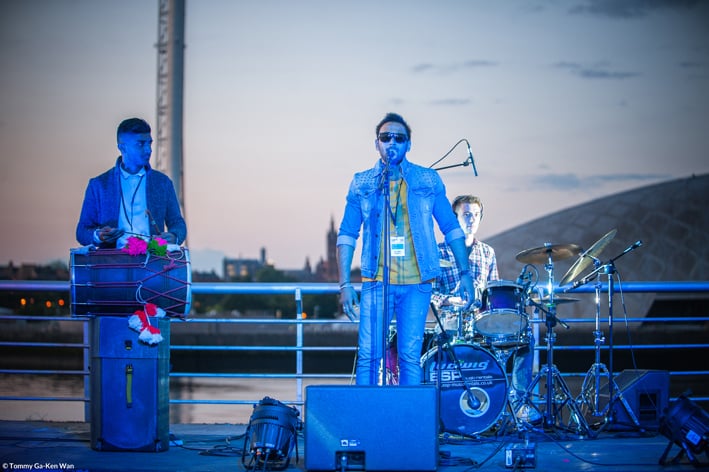
Performers in Sound of the Sea
Photo: Tommy Ga-Ken Wan
Heads up for match funding
Match funding has received some bad press recently, but Carl Watt has seen it work wonders at encouraging business sponsorship of the arts in Scotland.
Business sponsorship of the arts and culture in Scotland is currently being nurtured through the New Arts Sponsorship (NAS) grants programme, an initiative run by Arts & Business Scotland (A&BS). Despite recent criticism of match giving in relation to crowdfunding campaigns, where the notion was described as “not promising”, following research by University College London (UCL), we have found our match funding programme to be quite the opposite. Analysis of the first nine years of NAS has not only shown a significant demand for it but has also demonstrated that private-sector investment in the arts can create significant opportunities for both the arts and business.
A report by AP on the UCL research focussed on the use of match giving for crowdfunding campaigns. While in theory match funding is match funding, the reality is that it takes many different forms, all of which can differ vastly. While match funding for crowdfunding has raised speculation as to whether it can be lucrative, we have evidence of a rich and colourful picture of the impact of the business sector partnering with arts organisations.
We have also gathered more details on the business reasons for undertaking the sponsorship and the social impacts to be derived from the wide range of arts activities
Funded by the Scottish Government and managed by A&BS, the NAS programme encourages arts organisations to attract an eligible business to sponsor an aspect of their work which can then be further supported by £1-for-£1 match funding. The funding goes towards additional activity for which the business sponsor receives equivalent sponsorship benefits. The maximum grant available is £40,000 and the minimum £1,000. Both in-kind and cash sponsorships are eligible. The objectives for NAS grants are to encourage businesses to sponsor arts activity within Scotland for the first time and entice back businesses that have not sponsored the arts in Scotland for the past three financial years. The programme also supports arts organisations to attract non-Scottish based companies to sponsor activities in Scotland.
The grants programme not only provides Scotland’s arts and cultural organisations with a major incentive to encourage the growth of business sponsorship for their programming and activities, but also provides us and the Scottish Government with an invaluable source of quantitative data and qualitative information on the new partnerships being formed across the country.
In some ways the programme has become a victim of its own success. The number of applications annually has more than doubled since the initiative began and there has been a significant increase in the past four years in the number of small and medium-sized businesses recognising the value of the arts and the return on investment. The fund is replenished at the start of the financial year and in the first six months of this financial year 60% has been allocated to worthwhile projects. The success of the programme, and its ability to stimulate and encourage business sponsorship in the arts in turn, has supported hundreds of innovative arts activities and events at both community and national level.
We have built a series of measures into the NAS grants application and evaluation forms that provide information on which business sectors are most supportive of culture, the artforms being supported and the geographical areas where this activity takes place. Since April of last year we have also gathered more details on the business reasons for undertaking the sponsorship and the social impacts to be derived from the wide range of arts activities being produced. Our annual review and analysis of the programme provides evidence of how the objectives are achieved and is providing an overview of the many arts and business partnerships being formed.
Festivals have received the largest share of the total budget since the fund was created in 2006, followed by visual arts, theatre and music. The heritage sector is underperforming, securing only four of the 50 grants awarded last year, so we are currently reviewing how best to support the sector through this scheme or through the development of an additional strand that will specifically target needs. Arts and business partnerships outside the central belt are increasingly benefiting from the scheme with 50% of the grants made in 2014/15 going towards projects in regions including Shetland, Highlands, Borders, Western Isles, Renfrewshire and Argyll and Bute.
What is abundantly clear from these findings and the grants evaluation forms is that arts organisations are in a position to offer businesses innovative and creative sponsorship packages that go beyond the reach of other promotional platforms. It is also obvious that the continued Scottish Government funding support for the development of the scheme over the years has had an impact in attracting private-sector investment into Scotland’s arts and cultural sector, and in supporting the creation of many new arts activities for performance at home and abroad.
Looking forward, we need to keep up to date with the changing tide of arts sponsorship, share arts and business partnership stories to encourage further arts organisation and business engagement, support arts and cultural organisations in developing innovative approaches to attract future business partnerships and keep nurturing business sponsorship of the arts as a vital funding route in these times of austerity and public funding cuts. To not attempt to do so will create a future of missed opportunities for both the business and arts and cultural sectors.
Carl Watt is Projects Officer at Arts & Business Scotland.
www.aandbscotland.org.uk
Join the Discussion
You must be logged in to post a comment.